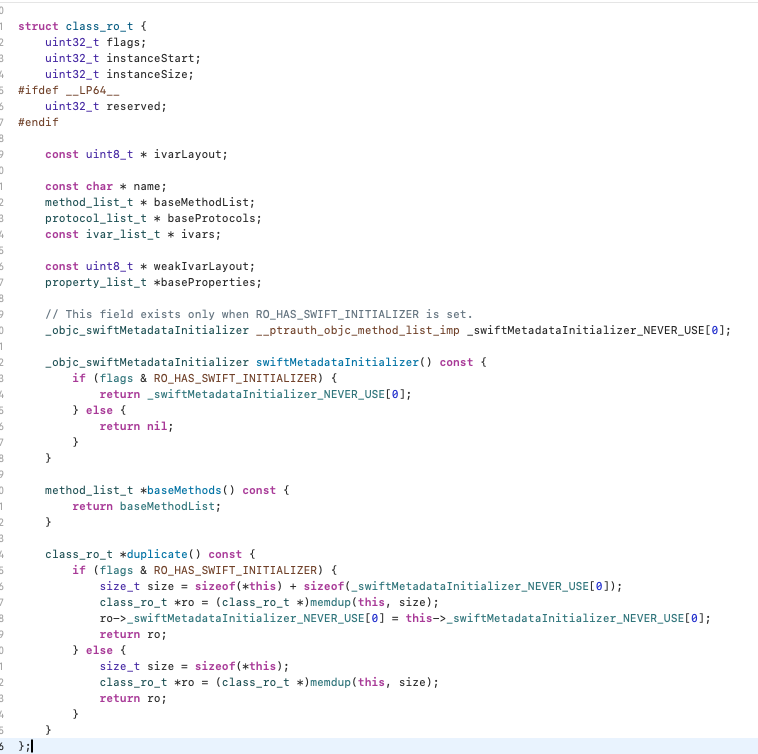
目录
- 一、list的介绍
- 二、 标准库中的list类
- 2.1 list的常见接口说明
- 2.1.1 list对象的常见构造
- 2.1.1.1 [无参构造函数](https://legacy.cplusplus.com/reference/list/list/list/)
- 2.1.1.2 [有参构造函数(构造并初始化n个val)](https://legacy.cplusplus.com/reference/list/list/list/)
- 2.1.1.3 [有参构造函数(使用迭代器进行初始化构造)](https://legacy.cplusplus.com/reference/list/list/list/)
- 2.1.1.4 [拷贝构造函数](https://legacy.cplusplus.com/reference/list/list/list/)
- 2.1.2 list iterator的使用
- 2.1.2.1 [begin()](https://legacy.cplusplus.com/reference/list/list/begin/) + [end()](https://legacy.cplusplus.com/reference/list/list/end/)
- 2.1.2.2 [rbegin()](https://legacy.cplusplus.com/reference/list/list/rbegin/) + [rend()](https://legacy.cplusplus.com/reference/list/list/rend/)
- 2.1.3 list对象的容量操作
- 2.1.3.1 [empty()函数](https://legacy.cplusplus.com/reference/list/list/empty/)
- 2.1.3.2 [size()函数](https://legacy.cplusplus.com/reference/list/list/size/)
- 2.1.4 list对象的增删查改及访问
- 2.1.4.1 [push_front()函数](https://legacy.cplusplus.com/reference/list/list/push_front/)
- 2.1.4.2 [pop_front()函数](https://legacy.cplusplus.com/reference/list/list/pop_front/)
- 2.1.4.3 [push_back()函数](https://legacy.cplusplus.com/reference/list/list/push_back/)
- 2.1.4.4 [pop_back()函数](https://legacy.cplusplus.com/reference/list/list/pop_back/)
- 2.1.4.5 [insert()函数](https://legacy.cplusplus.com/reference/list/list/insert/)
- 2.1.4.6 [erase()函数](https://legacy.cplusplus.com/reference/list/list/erase/)
- 2.1.4.7 [swap()函数](https://legacy.cplusplus.com/reference/list/list/swap/)
- 2.1.4.8 [clear()函数](https://legacy.cplusplus.com/reference/list/list/clear/)
- 2.1.4.9 [front()函数](https://legacy.cplusplus.com/reference/list/list/front/) + [back()函数](https://legacy.cplusplus.com/reference/list/list/back/)
- 2.1.5 list的迭代器失效
- 三、list的模拟实现
- 3.1 list 节点类的实现
- 3.2 list 中默认成员函数的实现
- 3.3 list 中 size、empty 和 swap 函数的实现
- 3.4 list 中 迭代器类 的实现
- 3.5 list 中 迭代器 、 范围构造函数 和 clear 函数 的实现
- 3.6 list 中 insert 和 erase 的实现
- 3.7 list 中 push_back、pop_back、push_front 和 pop_front 函数的实现
- 3.8 list 中 反向迭代器类 和 反向迭代器 的实现
- 3.9 list 实现汇总及函数测试
- 四、 list 与 vector 的对比
- 结尾
一、list的介绍
- list是可以在常数范围内在任意位置进行插入和删除的序列式容器,并且该容器可以前后双向迭代。
- list的底层是双向链表结构,双向链表中每个元素存储在互不相关的独立节点中,在节点中通过指针指向其前一个元素和后一个元素。
- list与forward_list非常相似:最主要的不同在于forward_list是单链表,只能朝前迭代,已让其更简单高效。
- 与其他的序列式容器相比(array,vector,deque),list通常在任意位置进行插入、移除元素的执行效率更好。
- 与其他序列式容器相比,list和forward_list最大的缺陷是不支持任意位置的随机访问,比如:要访问list的第6个元素,必须从已知的位置(比如头部或者尾部)迭代到该位置,在这段位置上迭代需要线性的时间开销;list还需要一些额外的空间,以保存每个节点的相关联信息(对于存储类型较小元素的大list来说这可能是一个重要的因素)
二、 标准库中的list类
2.1 list的常见接口说明
2.1.1 list对象的常见构造
2.1.1.1 无参构造函数
list();
int main()
{
list<int> l;
return 0;
}
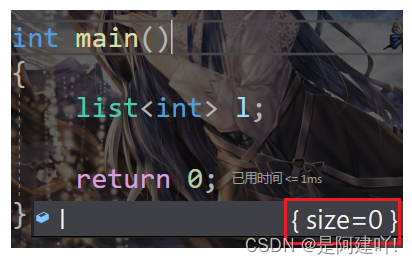
2.1.1.2 有参构造函数(构造并初始化n个val)
list (size_type n, const value_type& val = value_type());
int main()
{
list<int> l(5, 4);
return 0;
}

2.1.1.3 有参构造函数(使用迭代器进行初始化构造)
template <class InputIterator>
list (InputIterator first, InputIterator last);
int main()
{
string s("Love");
list<int> l(s.begin(), s.end());
return 0;
}

2.1.1.4 拷贝构造函数
list (const list& x);
int main()
{
list<int> l1(5,6);
list<int> l2(l1);
return 0;
}

2.1.2 list iterator的使用
2.1.2.1 begin() + end()
iterator begin();
const_iterator begin() const;
获取第一个数据位置的iterator/const_iterator
iterator end();
const_iterator end() const;
获取最后一个数据的下一个位置的iterator/const_iterator
int main()
{
list<int> l;
for (int i = 0; i < 10; i++)
{
l.push_back(i);
}
list<int>::iterator it = l.begin();
while (it != l.end())
{
cout << *it << ' ';
++it;
}
cout << endl;
return 0;
}
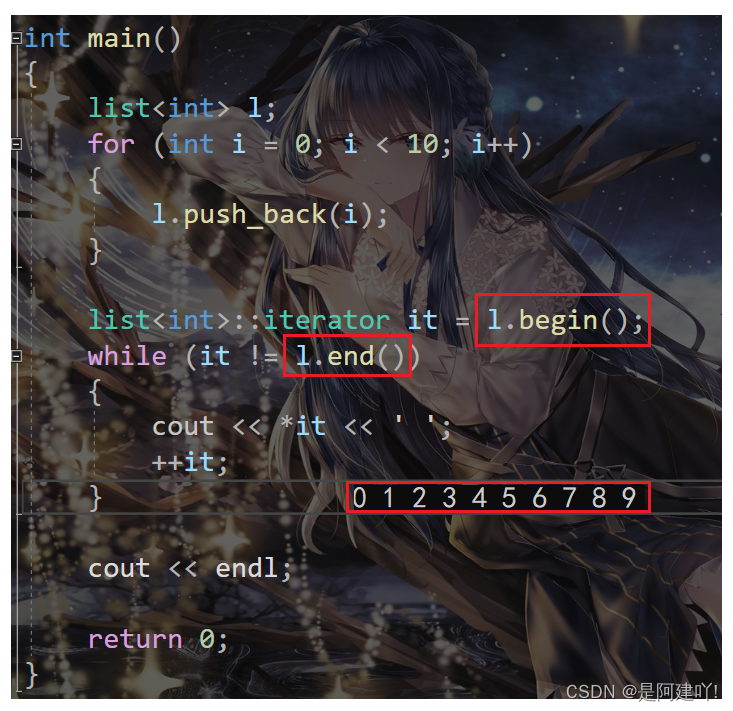
2.1.2.2 rbegin() + rend()
reverse_iterator rbegin();
const_reverse_iterator rbegin() const;
获取最后一个数据位置的reverse_iterator/const_reverse_iterator
reverse_iterator rend();
const_reverse_iterator rend() const;
获取第一个数据前一个位置的reverse_iterator/const_reverse_iterator
int main()
{
list<int> l;
for (int i = 0; i < 10; i++)
{
l.push_back(i);
}
list<int>::reverse_iterator it = l.rbegin();
while (it != l.rend())
{
cout << *it << ' ';
++it;
}
cout << endl;
return 0;
}
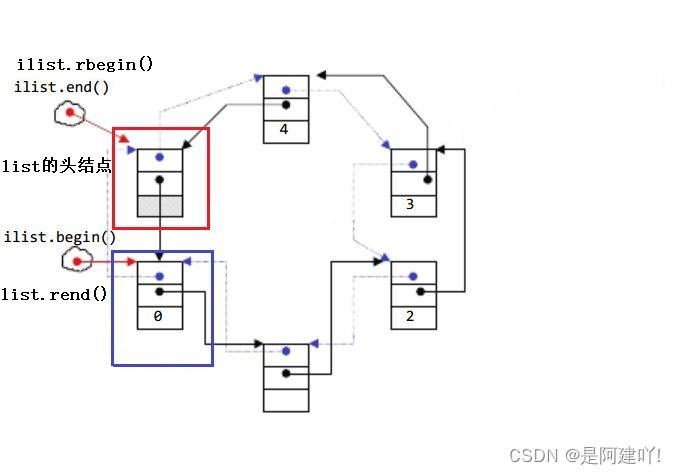
注意:
begin与end为正向迭代器,对迭代器执行++操作,迭代器向后移动rbegin与rend为反向迭代器,对迭代器执行++操作,迭代器向前移动
2.1.3 list对象的容量操作
2.1.3.1 empty()函数
bool empty() const; 判断是否为空
int main()
{
list<int> l;
cout << l.empty() << endl;
l.push_back(1);
cout << l.empty() << endl;
return 0;
}

2.1.3.2 size()函数
size_type size() const; 获取数据个数
int main()
{
list<int> l;
cout << l.size() << endl;
for (int i = 0; i < 10; i++)
{
l.push_back(i);
}
cout << l.size() << endl;
return 0;
}
2.1.4 list对象的增删查改及访问
2.1.4.1 push_front()函数
void push_front (const value_type& val); 头插
int main()
{
list<int> l;
l.push_front(1);
l.push_front(2);
l.push_front(3);
l.push_front(4);
for (auto e : l)
{
cout << e << ' ';
}
cout << endl;
return 0;
}
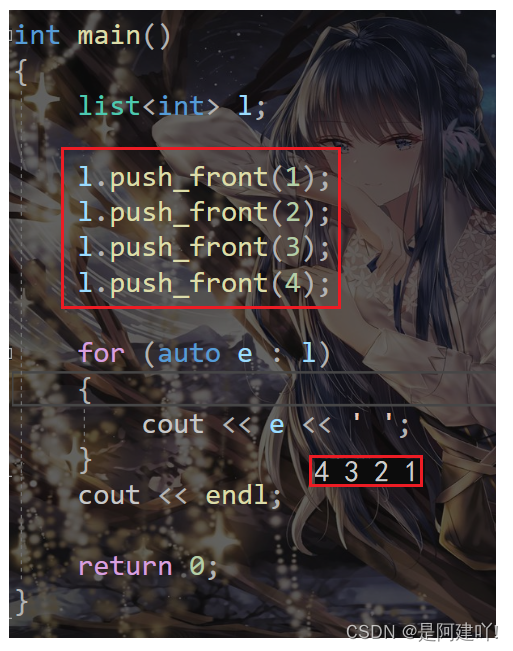
2.1.4.2 pop_front()函数
void pop_front(); 头删
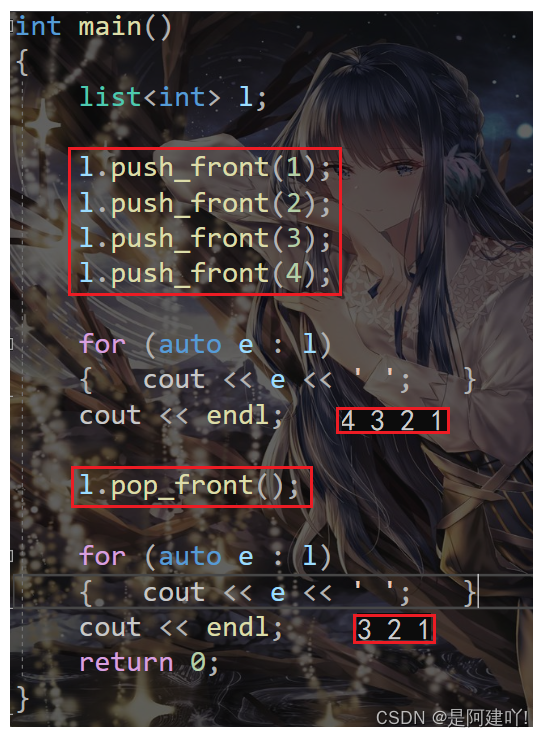
2.1.4.3 push_back()函数
void push_back (const value_type& val); 尾插
int main()
{
list<int> l;
l.push_back(1);
l.push_back(2);
l.push_back(3);
l.push_back(4);
for (auto e : l)
{
cout << e << ' ';
}
cout << endl;
return 0;
}

2.1.4.4 pop_back()函数
void pop_back(); 尾删
int main()
{
list<int> l;
l.push_back(1);
l.push_back(2);
l.push_back(3);
l.push_back(4);
for (auto e : l)
{ cout << e << ' '; }
cout << endl;
l.pop_back();
for (auto e : l)
{ cout << e << ' '; }
cout << endl;
return 0;
}
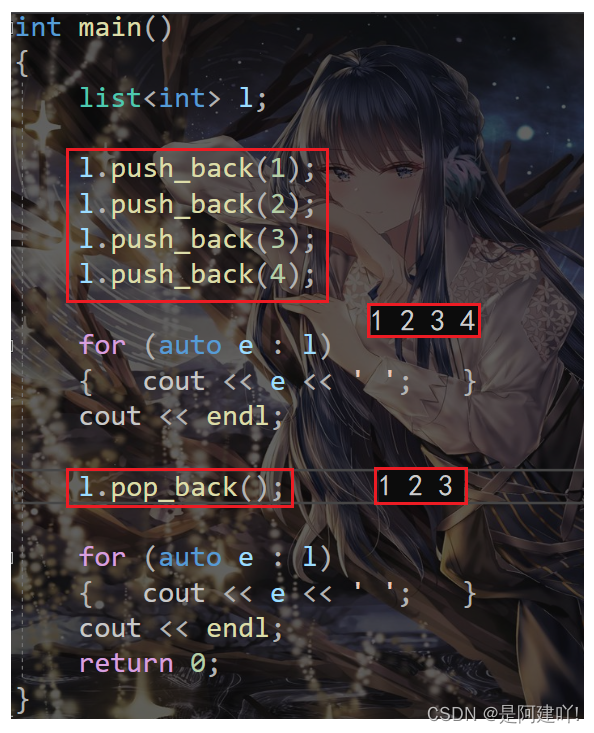
2.1.4.5 insert()函数
iterator insert (iterator position, const value_type& val);
insert()函数能够在position之前插入val,并返回插入数据位置的 iterator
void insert (iterator position, size_type n, const value_type& val);
insert()函数能够在position之前插入 n 个 val
template <class InputIterator>
void insert (iterator position, InputIterator first, InputIterator last);
insert()函数能够在position之前插入一段迭代器区间的数据
int main()
{
list<int> l;
string s("Love");
l.push_back(1);
l.push_back(2);
for (auto e : l)
{
cout << e << ' ';
}
cout << endl;
// insert()函数能够在position之前插入val,并返回插入数据位置的 iterator
cout << *(l.insert(l.begin(), 20)) << endl;
for (auto e : l)
{
cout << e << ' ';
}
cout << endl;
// insert()函数能够在position之前插入 n 个 val
l.insert(++l.begin() , 3 ,30);
for (auto e : l)
{
cout << e << ' ';
}
cout << endl;
// insert()函数能够在position之前插入一段迭代器区间的数据
l.insert(++l.begin(), s.begin() , s.end());
for (auto e : l)
{
cout << e << ' ';
}
cout << endl;
return 0;
}
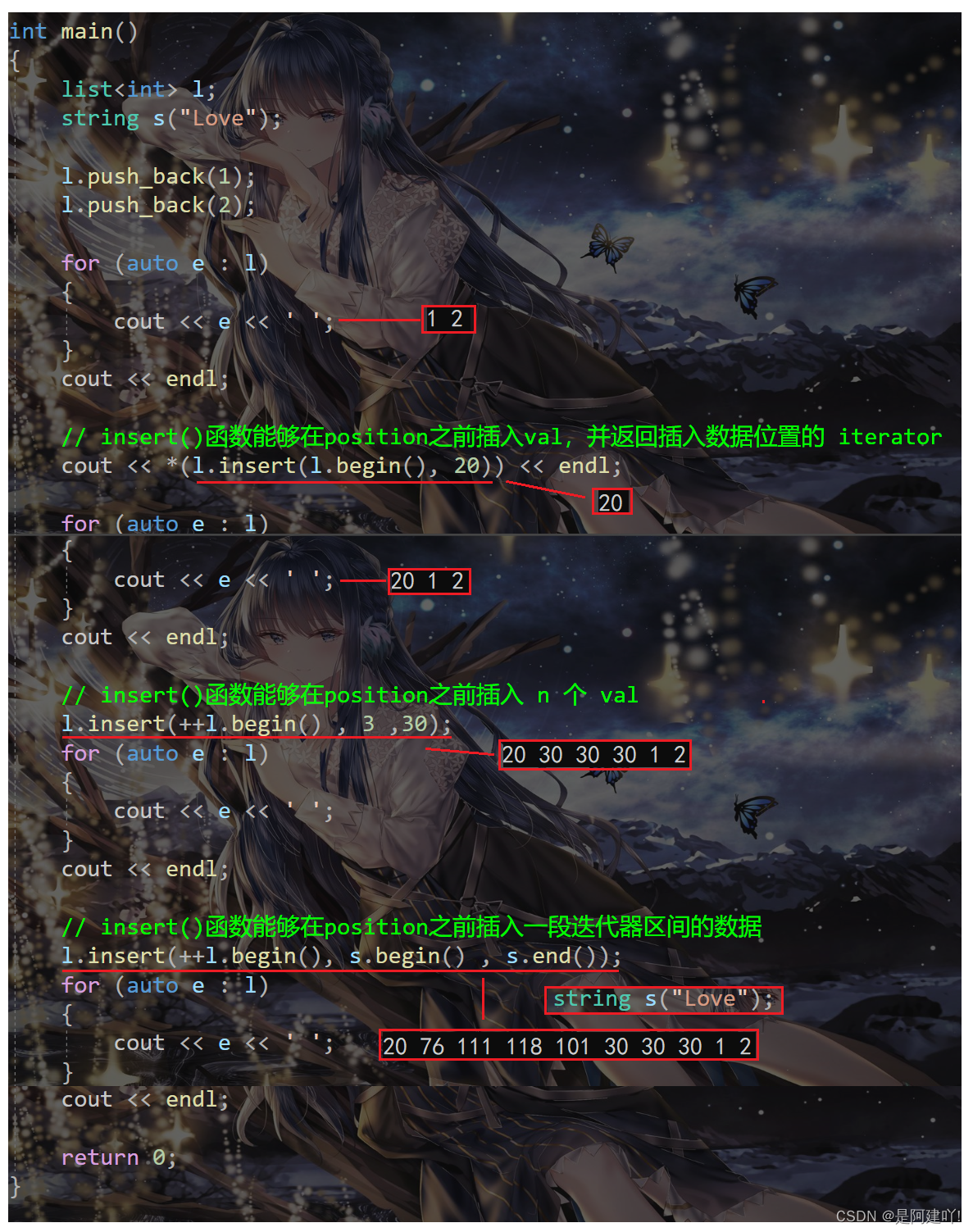
2.1.4.6 erase()函数
iterator erase (iterator position);
erase()函数能够删除在position位的的数据,并返回删除数据后面数据位置的 iterator
iterator erase (iterator first, iterator last);
erase()函数能够删除在迭代器区间 [first,last) 的的数据,并返回删除数据后面数据位置的 iterator
int main()
{
list<int> l;
for (int i = 0; i < 10; i++)
{
l.push_back(i);
}
cout << endl;
for (auto e : l)
{
cout << e << ' ';
}
cout << endl;
// erase()函数能够删除在position位的的数据
// 并返回删除数据后面数据位置的 iterator
cout << *(l.erase(l.begin())) << endl;
for (auto e : l)
{
cout << e << ' ';
}
cout << endl;
// erase()函数能够删除在迭代器区间 [first,last) 的的数据
// 并返回删除数据后面数据位置的 iterator
cout << *(l.erase(++l.begin(),--l.end())) << endl;
for (auto e : l)
{
cout << e << ' ';
}
cout << endl;
return 0;
}

2.1.4.7 swap()函数
void swap (list& x);
交换两个list的数据空间
int main()
{
list<int> l1(4, 10);
list<int> l2(5, 5);
for (auto e : l1)
{ cout << e << ' '; }
cout << endl;
for (auto e : l2)
{ cout << e << ' '; }
cout << endl;
l1.swap(l2);
for (auto e : l1)
{ cout << e << ' '; }
cout << endl;
for (auto e : l2)
{ cout << e << ' '; }
cout << endl;
return 0;
}
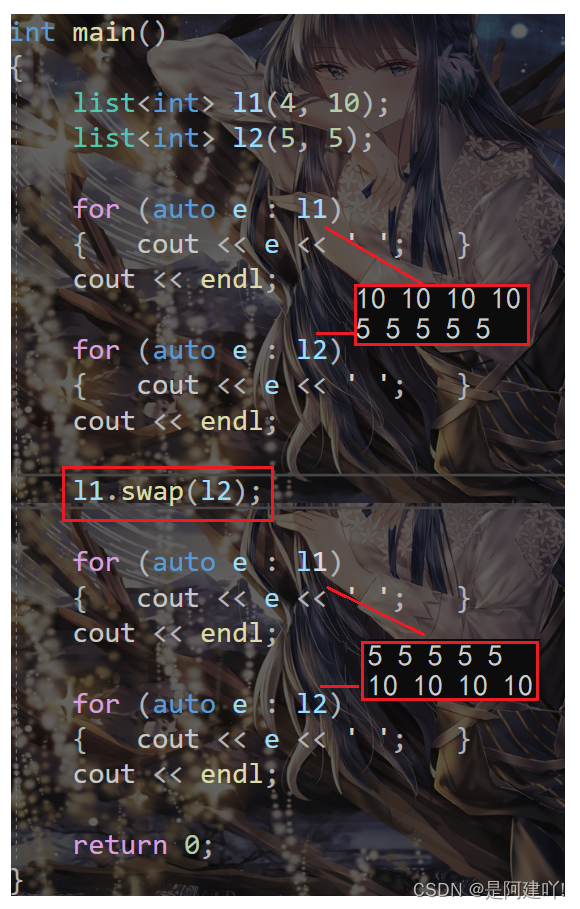
2.1.4.8 clear()函数
void clear();
清除list中的有效数据
int main()
{
list<int> l(4, 10);
cout << l.size() << endl;
l.clear();
cout << l.size() << endl;
return 0;
}
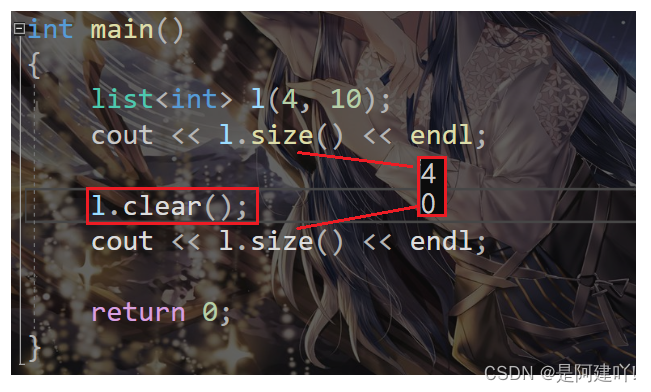
2.1.4.9 front()函数 + back()函数
访问list中的第一个数据
reference front();
const_reference front() const;
访问list中的最后一个数据
reference back();
const_reference back() const;
int main()
{
list<int> l;
for (int i = 0; i < 10; i++)
{
l.push_back(i);
}
cout << "front:" << l.front() << endl;
cout << "back:" << l.back() << endl;
return 0;
}
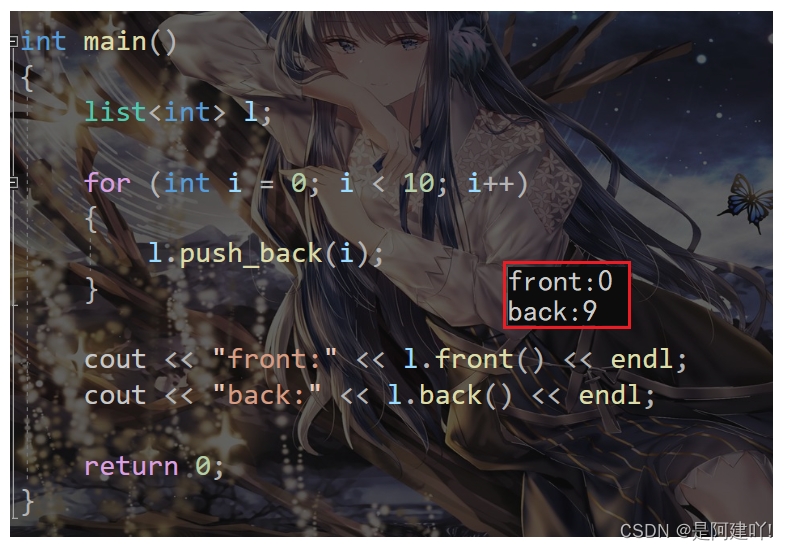
2.1.5 list的迭代器失效
前面说过,此处大家可将迭代器暂时理解成类似于指针,迭代器失效即迭代器所指向的节点的无效,即该节点被删除了。因为list的底层结构为带头结点的双向循环链表,因此在list中进行插入时是不会导致list的迭代器失效的,只有在删除时才会失效,并且失效的只是指向被删除节点的迭代器,其他迭代器不会受到影响。
int main()
{
int array[] = { 1, 2, 3, 4, 5, 6, 7, 8, 9, 0 };
list<int> l(array, array + sizeof(array) / sizeof(array[0]));
auto it = l.begin();
while (it != l.end())
{
// erase()函数执行后,it所指向的节点已被删除
// 因此it无效,在下一次使用it时,必须先给其赋值
l.erase(it);
++it;
}
return 0;
}
// 改正
int main()
{
int array[] = { 1, 2, 3, 4, 5, 6, 7, 8, 9, 0 };
list<int> l(array, array + sizeof(array) / sizeof(array[0]));
auto it = l.begin();
while (it != l.end())
{
l.erase(it++); // it = l.erase(it);
}
}
三、list的模拟实现
3.1 list 节点类的实现
namespace aj
{
// List的节点类
template<class T>
struct ListNode
{
ListNode(const T& val = T())
:_val(val)
{}
ListNode<T>* _prev = nullptr;
ListNode<T>* _next = nullptr;
T _val;
};
};
3.2 list 中默认成员函数的实现
namespace aj
{
//list
template<class T>
class list
{
typedef ListNode<T> Node;
typedef Node* PNode;
public:
// List的构造
list()
{
CreateHead();
}
// 构造并用n个val初始化
list(int n, const T& value = T())
{
CreateHead();
while (n--)
{
push_back(value);
}
}
// 链表的拷贝构造
// list(const list<T>& l)
list(list<T>& l)
{
CreateHead();
for (auto e : l)
{
push_back(e);
}
}
list<T>& operator=(const list<T> l)
{
swap(l);
return *this;
}
~list()
{
clear();
delete _head;
_head = nullptr;
}
void swap(list<T>& l)
{
std::swap(_head, l._head);
std::swap(_size, l._size);
}
private:
void CreateHead()
{
_head = new Node();
_head->_next = _head;
_head->_prev = _head;
_size = 0;
}
PNode _head; // 头结点
int _size; // 记录链表中节点的个数
};
};
3.3 list 中 size、empty 和 swap 函数的实现
namespace aj
{
template<class T>
class list
{
typedef ListNode<T> Node;
typedef Node* PNode;
public:
size_t size()const
{
return size;
}
bool empty()const
{
return _head->_next == _head && _head->_prev == _head;
}
void swap(list<T>& l)
{
std::swap(_head, l._head);
std::swap(_size, l._size);
}
private:
void CreateHead()
{
_head = new Node();
_head->_next = _head;
_head->_prev = _head;
_size = 0;
}
PNode _head; // 头结点
int _size; // 记录链表中节点的个数
};
};
3.4 list 中 迭代器类 的实现
namespace aj
{
//List的迭代器类
//template<class T>
template<class T, class Ref, class Ptr>
struct ListIterator
{
typedef ListNode<T>* PNode;
typedef ListIterator<T, Ref, Ptr> Self;
// 成员变量
PNode _pNode;
public:
// 迭代器的构造函数
ListIterator(PNode pNode = nullptr)
:_pNode(pNode)
{}
Ref operator*()
{
return _pNode->_val;
}
Ptr operator->()
{
return &(_pNode->_val);
}
Self& operator++()
{
_pNode = _pNode->_next;
return *this;
}
Self operator++(int)
{
Self tmp(*this);
++* this;
return tmp;
}
Self& operator--()
{
_pNode = _pNode->_prev;
return *this;
}
Self operator--(int)
{
Self tmp(*this);
--* this;
return tmp;
}
bool operator!=(const Self& l)
{
return _pNode != l._pNode;
}
bool operator==(const Self& l)
{
return _pNode == l._pNode;
}
};
};
3.5 list 中 迭代器 、 范围构造函数 和 clear 函数 的实现
namespace aj
{
template<class T>
class list
{
typedef ListNode<T> Node;
typedef Node* PNode;
public:
typedef ListIterator<T, T&, T*> iterator;
typedef ListIterator<T, const T&, const T&> const_iterator;
template <class Iterator>
list(Iterator first, Iterator last)
{
CreateHead();
while (first != last)
{
push_back(first._pNode->_val);
++first;
}
}
// List Iterator
iterator begin()
{
// return iterator(_head->_next);
return _head->_next;
}
iterator end()
{
// return iterator(_head);
return _head;
}
const_iterator begin()const
{
return _head->_next;
}
const_iterator end()const
{
return _head;
}
void clear()
{
list<T>::iterator lit = begin();
while (lit != end())
{
lit = erase(lit);
}
}
private:
void CreateHead()
{
_head = new Node();
_head->_next = _head;
_head->_prev = _head;
_size = 0;
}
PNode _head; // 头结点
int _size; // 记录链表中节点的个数
};
};
3.6 list 中 insert 和 erase 的实现
namespace aj
{
template<class T>
class list
{
typedef ListNode<T> Node;
typedef Node* PNode;
public:
typedef ListIterator<T, T&, T*> iterator;
typedef ListIterator<T, const T&, const T&> const_iterator;
// 在pos位置前插入值为val的节点,返回插入新节点的位置
iterator insert(iterator pos, const T& val)
{
// 通过迭代器找到所需的节点指针
Node* cur = pos._pNode;
Node* prev = cur->_prev;
// 创建新的节点
Node* newnode = new Node(val);
// 节点间相互连接
newnode->_prev = prev;
prev->_next = newnode;
cur->_prev = newnode;
newnode->_next = cur;
// 节点数量++
_size++;
//return iterator(newnode);
return newnode;
}
// 删除pos位置的节点,返回该节点的下一个位置
iterator erase(iterator pos)
{
assert(_size > 0);
// 找到所需要的节点指针
Node* cur = pos._pNode;
Node* next = cur->_next;
Node* prev = cur->_prev;
// 节点相互连接
next->_prev = prev;
prev->_next = next;
// 删除节点
delete cur;
cur = nullptr;
// 减少节点数目
--_size;
// 返回删除节点的下一个位置
// return iterator(next);
return next;
}
private:
void CreateHead()
{
_head = new Node();
_head->_next = _head;
_head->_prev = _head;
_size = 0;
}
PNode _head; // 头结点
int _size; // 记录链表中节点的个数
};
};
3.7 list 中 push_back、pop_back、push_front 和 pop_front 函数的实现
namespace aj
{
template<class T>
class list
{
public:
typedef ListNode<T> Node;
typedef Node* PNode;
void push_back(const T& val) { insert(end(), val); }
void pop_back() { erase(--end()); }
void push_front(const T& val) { insert(begin(), val); }
void pop_front() { erase(begin()); }
private:
PNode _head; // 头结点
int _size; // 记录链表中节点的个数
};
};
3.8 list 中 反向迭代器类 和 反向迭代器 的实现
反向迭代器的++就是正向迭代器的--,反向迭代器的--就是正向迭代器的++,因此反向迭代器的实现可以借助正向迭代器,即:反向迭代器内部可以包含一个正向迭代器,对正向迭代器的接口进行包装即可。
注意:反向迭代器类可以被所有的容器封装成反向迭代器使用。
下面两种反向迭代器的实现虽然不同,但是功能是相同的。反向迭代器类的实现不同,那么对应封装迭代器的时候也要做出相应的改变。
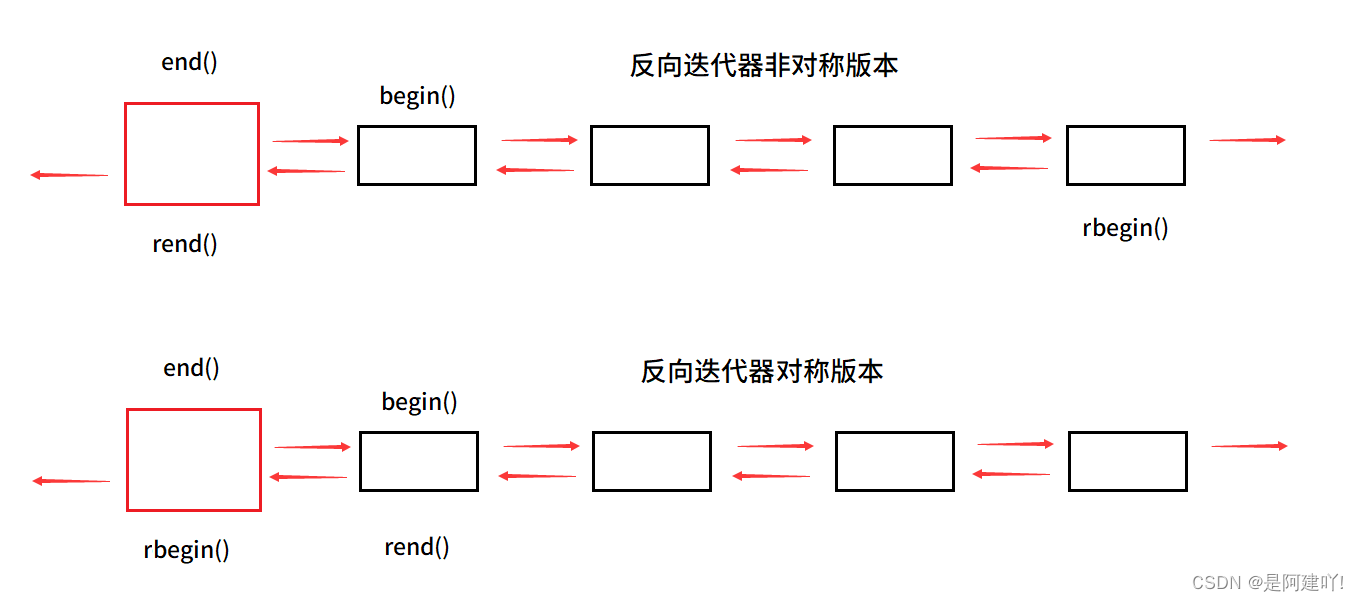
reverse_iterator.h 反向迭代器非对称版本
#pragma once
// 不对称版本
namespace aj
{
// 适配器 -- 复用
template<class Iterator, class Ref, class Ptr>
struct Reverse_iterator
{
typedef Reverse_iterator<Iterator,Ref,Ptr> Self;
Reverse_iterator(const Iterator& it)
:_it(it)
{}
Ref operator*()
{
return *_it;
}
Ptr operator->()
{
return _it.operator->();
}
Self& operator++()
{
--_it;
return *this;
}
Self operator++(int)
{
Self tmp(*this);
--_it;
return tmp;
}
Self& operator--()
{
++_it;
return *this;
}
Self operator--(int)
{
Self tmp(*this);
++_it;
return tmp;
}
bool operator!=(const Self& s)
{
return _it != s._it;
}
bool operator==(const Self& s)
{
return _it == s._it;
}
Iterator _it;
};
}
list.h 反向迭代器非对称版本
#include"reverse_iterator.h"
namespace aj
{
template<class T>
class list
{
public:
typedef ListNode<T> Node;
typedef Node* PNode;
public:
// typedef ListIterator<T> iterator;
typedef ListIterator<T, T&, T*> iterator;
typedef ListIterator<T, const T&, const T&> const_iterator;
typedef Reverse_iterator<iterator, T&, T*> reverse_iterator;
typedef Reverse_iterator<const_iterator, const T&, const T*> const_reverse_iterator;
public:
// reverse_iterator 不对称版本
reverse_iterator rbegin()
{
// return iterator(_head->_next);
return --end(); //这里可以使用--end()也可以使用end()-1,但是没有写operator-()
} //这里就使用--end(),这里能使用--end()的原因是
//end()返回传值返回的自定义类型的临时对象,具有常性,是常量
//但是这里有编译器的特殊处理
//使得const对象可以调用非const成员函数
reverse_iterator rend()
{
// return iterator(_head);
return end();
}
const_reverse_iterator rbegin()const
{
return --end();
}
const_reverse_iterator rend()const
{
return end();
}
private:
void CreateHead()
{
_head = new Node();
_head->_next = _head;
_head->_prev = _head;
_size = 0;
}
PNode _head; // 头结点
int _size; // 记录链表中节点的个数
};
};
reverse_iterator.h 反向迭代器对称版本
#pragma once
// 对称版本
namespace aj
{
// 适配器 -- 复用
template<class Iterator, class Ref, class Ptr>
struct Reverse_iterator
{
typedef Reverse_iterator<Iterator,Ref,Ptr> Self;
Reverse_iterator(const Iterator& it)
:_it(it)
{}
Ref operator*()
{
Iterator tmp(_it);
return *--tmp;
}
Ptr operator->()
{
return --_it.operator->();
}
Self& operator++()
{
--_it;
return *this;
}
Self operator++(int)
{
Self tmp(*this);
--_it;
return tmp;
}
Self& operator--()
{
++_it;
return *this;
}
Self operator--(int)
{
Self tmp(*this);
++_it;
return tmp;
}
bool operator!=(const Self& s)
{
return _it != s._it;
}
bool operator==(const Self& s)
{
return _it == s._it;
}
Iterator _it;
};
}
list.h 反向迭代器对称版本
#include"reverse_iterator.h"
namespace aj
{
template<class T>
class list
{
public:
typedef ListNode<T> Node;
typedef Node* PNode;
public:
// typedef ListIterator<T> iterator;
typedef ListIterator<T, T&, T*> iterator;
typedef ListIterator<T, const T&, const T&> const_iterator;
typedef Reverse_iterator<iterator, T&, T*> reverse_iterator;
typedef Reverse_iterator<const_iterator, const T&, const T*> const_reverse_iterator;
public:
// reverse_iterator 对称版本
reverse_iterator rbegin()
{
// return iterator(_head->_next);
return end();
}
reverse_iterator rend()
{
// return iterator(_head);
return begin();
}
const_reverse_iterator rbegin()const
{
return end();
}
const_reverse_iterator rend()const
{
return begin();
}
private:
void CreateHead()
{
_head = new Node();
_head->_next = _head;
_head->_prev = _head;
_size = 0;
}
PNode _head; // 头结点
int _size; // 记录链表中节点的个数
};
};
3.9 list 实现汇总及函数测试
reverse_iterator.h
#pragma once
// 不对称版本
//namespace aj
//{
// // 适配器 -- 复用
// template<class Iterator, class Ref, class Ptr>
// struct Reverse_iterator
// {
// typedef Reverse_iterator<Iterator,Ref,Ptr> Self;
//
// Reverse_iterator(const Iterator& it)
// :_it(it)
// {}
//
// Ref operator*()
// {
// return *_it;
// }
//
// Ptr operator->()
// {
// return _it.operator->();
// }
//
// Self& operator++()
// {
// --_it;
// return *this;
// }
//
// Self operator++(int)
// {
// Self tmp(*this);
// --_it;
// return tmp;
// }
//
// Self& operator--()
// {
// ++_it;
// return *this;
// }
//
// Self operator--(int)
// {
// Self tmp(*this);
// ++_it;
// return tmp;
// }
//
// bool operator!=(const Self& s)
// {
// return _it != s._it;
// }
//
// bool operator==(const Self& s)
// {
// return _it == s._it;
// }
// Iterator _it;
// };
//}
// 对称版本
namespace aj
{
// 适配器 -- 复用
template<class Iterator, class Ref, class Ptr>
struct Reverse_iterator
{
typedef Reverse_iterator<Iterator,Ref,Ptr> Self;
Reverse_iterator(const Iterator& it)
:_it(it)
{}
Ref operator*()
{
Iterator tmp(_it);
return *--tmp;
}
Ptr operator->()
{
return --_it.operator->();
}
Self& operator++()
{
--_it;
return *this;
}
Self operator++(int)
{
Self tmp(*this);
--_it;
return tmp;
}
Self& operator--()
{
++_it;
return *this;
}
Self operator--(int)
{
Self tmp(*this);
++_it;
return tmp;
}
bool operator!=(const Self& s)
{
return _it != s._it;
}
bool operator==(const Self& s)
{
return _it == s._it;
}
Iterator _it;
};
}
list.h
#pragma once
#include<iostream>
#include<assert.h>
#include <string>
#include <vector>
using namespace std;
#include"reverse_iterator.h"
namespace aj
{
// List的节点类
template<class T>
struct ListNode
{
ListNode(const T& val = T())
:_val(val)
{}
ListNode<T>* _prev = nullptr;
ListNode<T>* _next = nullptr;
T _val;
};
//List的迭代器类
//template<class T>
template<class T, class Ref, class Ptr>
struct ListIterator
{
typedef ListNode<T>* PNode;
typedef ListIterator<T ,Ref , Ptr> Self;
// 成员变量
PNode _pNode;
// typedef ListIterator<T, Ref, Ptr> Self;
public:
// 迭代器的构造函数
ListIterator(PNode pNode = nullptr)
:_pNode(pNode)
{}
Ref operator*()
{
return _pNode->_val;
}
Ptr operator->()
{
return &(_pNode->_val);
}
Self& operator++()
{
_pNode = _pNode->_next;
return *this;
}
Self operator++(int)
{
Self tmp(*this);
++* this;
return tmp;
}
Self& operator--()
{
_pNode = _pNode->_prev;
return *this;
}
Self operator--(int)
{
Self tmp(*this);
--* this;
return tmp;
}
bool operator!=(const Self& l)
{
return _pNode != l._pNode;
}
bool operator==(const Self& l)
{
return _pNode == l._pNode;
}
};
//list类
template<class T>
class list
{
public:
typedef ListNode<T> Node;
typedef Node* PNode;
public:
// typedef ListIterator<T> iterator;
typedef ListIterator<T, T&, T*> iterator;
typedef ListIterator<T, const T&, const T&> const_iterator;
typedef Reverse_iterator<iterator, T&, T*> reverse_iterator;
typedef Reverse_iterator<const_iterator,const T&,const T*> const_reverse_iterator;
public:
///
// List的构造
list()
{
CreateHead();
}
list(int n, const T& value = T())
{
CreateHead();
while (n--)
{
push_back(value);
}
}
template <class Iterator>
list(Iterator first, Iterator last)
{
CreateHead();
while (first != last)
{
push_back(first._pNode->_val);
++first;
}
}
// 链表的拷贝构造
// list(const list<T>& l)
list(list<T>& l)
{
CreateHead();
for (auto e : l)
{
push_back(e);
}
}
//list<T>& operator=(const list<T> l)
list<T>& operator=(list<T> l)
{
swap(l);
return *this;
}
~list()
{
clear();
delete _head;
_head = nullptr;
}
///
// List Iterator
iterator begin()
{
// return iterator(_head->_next);
return _head->_next;
}
iterator end()
{
// return iterator(_head);
return _head;
}
const_iterator begin()const
{
return _head->_next;
}
const_iterator end()const
{
return _head;
}
reverse_iterator 不对称版本
//reverse_iterator rbegin()
//{
// // return iterator(_head->_next);
// return --end(); //这里可以使用--end()也可以使用end()-1,但是没有写operator-()
//} //这里就使用--end(),这里能使用--end()的原因是
// //end()返回传值返回的自定义类型的临时对象,具有常性,是常量
// //但是这里有编译器的特殊处理
// //使得const对象可以调用非const成员函数
//reverse_iterator rend()
//{
// // return iterator(_head);
// return end();
//}
//const_reverse_iterator rbegin()const
//{
// return --end();
//}
//const_reverse_iterator rend()const
//{
// return end();
//}
// reverse_iterator 对称版本
reverse_iterator rbegin()
{
// return iterator(_head->_next);
return end();
}
reverse_iterator rend()
{
// return iterator(_head);
return begin();
}
const_reverse_iterator rbegin()const
{
return end();
}
const_reverse_iterator rend()const
{
return begin();
}
///
// List Capacity
size_t size()const
{
return size;
}
bool empty()const
{
return _head->_next == _head && _head->_prev == _head;
}
// List Access
T& front()
{
assert(_head->_next != _head);
return _head->_next->_val;
}
const T& front()const
{
assert(_head->_next != _head);
return _head->_next->_val;
}
T& back()
{
assert(_head->_prev != _head);
return _head->_prev->_val;
}
const T& back()const
{
assert(_head->_prev != _head);
return _head->_prev->_val;
}
// List Modify
void push_back(const T& val) { insert(end(), val); }
void pop_back() { erase(--end()); }
void push_front(const T& val) { insert(begin(), val); }
void pop_front() { erase(begin()); }
// 在pos位置前插入值为val的节点,返回插入新节点的位置
iterator insert(iterator pos, const T& val)
{
// 通过迭代器找到所需的节点指针
Node* cur = pos._pNode;
Node* prev = cur->_prev;
// 创建新的节点
Node* newnode = new Node(val);
// 节点间相互连接
newnode->_prev = prev;
prev->_next = newnode;
cur->_prev = newnode;
newnode->_next = cur;
// 节点数量++
_size++;
//return iterator(newnode);
return newnode;
}
// 删除pos位置的节点,返回该节点的下一个位置
iterator erase(iterator pos)
{
assert(_size > 0);
// 找到所需要的节点指针
Node* cur = pos._pNode;
Node* next = cur->_next;
Node* prev = cur->_prev;
// 节点相互连接
next->_prev = prev;
prev->_next = next;
// 删除节点
delete cur;
cur = nullptr;
// 减少节点数目
--_size;
// 返回删除节点的下一个位置
// return iterator(next);
return next;
}
void clear()
{
list<T>::iterator lit = begin();
while (lit != end())
{
lit = erase(lit);
}
}
void swap(list<T>& l)
{
std::swap(_head, l._head);
std::swap(_size, l._size);
}
private:
void CreateHead()
{
_head = new Node();
_head->_next = _head;
_head->_prev = _head;
_size = 0;
}
PNode _head; // 头结点
int _size; // 记录链表中节点的个数
};
struct AA
{
AA(int a1 = 0 , int a2 = 0)
:_a1(a1)
,_a2(a2)
{}
int _a1;
int _a2;
};
//template<class T>
//void print_list(const list<T>& l)
//{
// // list<T>未实例化的类模板,编译器不能去他里面去找
// // 那么编译器就无法确定这里的
// // const_iterator是静态变量还是内嵌类型
// // 加上typename就相当于告诉编译器这里是内嵌类型
// // 等list<T>初始化后再到类中去取
// typename list<T>::const_iterator it = l.begin();
// while (it != l.end())
// {
// cout << *it << ' ';
// ++it;
// }
// cout << endl;
//}
template<class Container>
void print_container(const Container& l)
{
typename Container::const_iterator it = l.begin();
while (it != l.end())
{
cout << *it << ' ';
++it;
}
cout << endl;
}
///
// 测试无参构造、n个val的构造、迭代器区间构造
void test_list1()
{
list<int> l;
l.push_back(1);
l.push_back(2);
l.push_back(3);
l.push_back(4);
l.push_back(5);
list<int> l1(10, 20);
list<int> l2(++l1.begin(), --l1.end());
for (auto e : l)
{
cout << e << ' ';
}
cout << endl;
for (auto e : l1)
{
cout << e << ' ';
}
cout << endl;
for (auto e : l2)
{
cout << e << ' ';
}
cout << endl;
}
// 测试 insert push_back push_front
// 测试 iterator 范围for
// 测试 operator != operator*
void test_list2()
{
list<int> l;
l.push_back(1);
l.push_back(2);
l.push_back(3);
l.push_back(4);
l.push_back(5);
l.push_front(10);
l.push_front(20);
list<int>::iterator lit = l.begin();
while (lit != l.end())
{
cout << *lit << ' ';
++lit;
}
cout << endl;
for (auto& e : l)
{
e += 10;
cout << e << ' ';
}
cout << endl;
}
// 测试 erase pop_back pop_front
void test_list3()
{
list<int> l;
l.push_back(1);
l.push_back(2);
l.push_back(3);
l.push_back(4);
l.push_back(5);
for (auto e : l)
{
cout << e << ' ';
}
cout << endl;
l.pop_back();
for (auto e : l)
{
cout << e << ' ';
}
cout << endl;
l.pop_front();
for (auto e : l)
{
cout << e << ' ';
}
cout << endl;
}
// 测试 operator++ operator++(int)
// 测试 operator-- operator--(int)
void test_list4()
{
list<int> l;
l.push_back(1);
l.push_back(2);
l.push_back(3);
l.push_back(4);
l.push_back(5);
list<int>::iterator lit1 = l.begin();
cout << *(lit1++) << endl;
cout << *(++lit1) << endl;
list<int>::iterator lit2 = l.end();
cout << *(--lit2) << endl;
cout << *(lit2--) << endl;
cout << endl;
}
// 测试 operator== operator!=
void test_list5()
{
list<int> l;
l.push_back(1);
l.push_back(2);
l.push_back(3);
l.push_back(4);
l.push_back(5);
list<int>::iterator lit = l.end();
cout << (lit == lit) << endl;
cout << (lit != lit) << endl;
cout << endl;
}
void test_list6()
{
list<int> l;
l.push_back(1);
l.push_back(2);
l.push_back(3);
for (auto e : l)
{
cout << e << ' ';
}
cout << endl;
cout << l.front() << ' ' << l.back() << endl;
l.pop_back();
l.pop_front();
for (auto e : l)
{
cout << e << ' ';
}
cout << endl;
cout << l.front() << ' ' << l.back() << endl;
l.pop_back();
l.pop_front();
for (auto e : l)
{
cout << e << ' ';
}
cout << endl;
cout << l.front() << ' ' << l.back() << endl;
}
// 测试 operator->
void test_list7()
{
list<AA> l1;
l1.push_back(AA(1, 1));
l1.push_back(AA(2, 2));
l1.push_back(AA(3, 3));
l1.push_back(AA(4, 4));
list<AA>::iterator it = l1.begin();
while (it != l1.end())
{
cout << it->_a1 << ' ' << it->_a2 << endl;
++it;
}
}
// 测试拷贝构造和赋值重载
void test_list8 ()
{
list<int> l1;
l1.push_back(1);
l1.push_back(2);
l1.push_back(3);
l1.push_back(4);
// 拷贝构造l2
list<int> l2(l1);
// 输出l1和l2的值
for (auto e : l1)
{
cout << e << ' ';
}
cout << endl;
for (auto e : l2)
{
cout << e << ' ';
}
cout << endl;
// l2中的值都*10,并输出
for (auto& e : l2)
{
e *= 10;
cout << e << ' ';
}
cout << endl;
// 将l2赋值给l1
l1 = l2;
// 输出l1和l2的值
for (auto e : l1)
{
cout << e << ' ';
}
cout << endl;
for (auto e : l2)
{
cout << e << ' ';
}
cout << endl;
}
// 测试print_container
void test_list9()
{
list<int> l1;
l1.push_back(1);
l1.push_back(2);
l1.push_back(3);
l1.push_back(4);
print_container(l1);
list<string> l2;
l2.push_back("1111111111111111111");
l2.push_back("2222222222222222222");
l2.push_back("3333333333333333333");
l2.push_back("4444444444444444444");
print_container(l2);
vector<string> v;
v.push_back("1111111111111111111");
v.push_back("2222222222222222222");
v.push_back("3333333333333333333");
v.push_back("4444444444444444444");
print_container(v);
}
void test_list10()
{
list<int> l1;
l1.push_back(1);
l1.push_back(2);
l1.push_back(3);
l1.push_back(4);
list<int>::reverse_iterator it = l1.rbegin();
while (it != l1.rend())
{
cout << *it << ' ';
++it;
}
cout << endl;
}
};
四、 list 与 vector 的对比
vector与list都是STL中非常重要的序列式容器,由于两个容器的底层结构不同,导致其特性以及应用场景不同,其主要不同如下:
| vector | list | |
|---|---|---|
| 底层结构 | 动态顺序表,一段连续空间 | 带头结点的双向循环链 |
| 访问 | 支持随机访问,访问某个元素的效率O(1) | 不支持随机访问,访问某个元素的效率为O(N) |
| 插入和删除 | 头部和中部的插入效率低,因为需要移动大量数据,效率为O(N),尾插和尾删的效率高,效率为O(1) 。插入时有可能需要增容,增容:开辟新空间,拷贝元素,释放旧空间,导致效率更低 | 任意位置的插入和删除效率高,不需要移动数据,效率为O(N) |
| 空间利用率 | 底层为连续空间,不容易造成内存碎片,空间利用率高,缓存利用率高 | 底层节点动态开辟,小节点容易造成内存碎片,空间利用率低,缓存利用率低 |
| 迭 代 器 失 效 | 在插入元素时,要给所有的迭代器重新赋值,因为插入元素有可能会导致重新扩容,致使原来迭代器失效,删除时,当前迭代器需要重新赋值否则会失效 | 插入元素不会导致迭代器失效,删除元素时,只会导致当前迭代器失效,其他迭代器不受影响 |
| 使 用 场 景 | 需要高效存储,支持随机访问,不关心插入删除效率 | 大量插入和删除操作,不关心随机访问 |
结尾
如果有什么建议和疑问,或是有什么错误,大家可以在评论区中提出。
希望大家以后也能和我一起进步!!🌹🌹
如果这篇文章对你有用的话,希望大家给一个三连支持一下!!🌹🌹



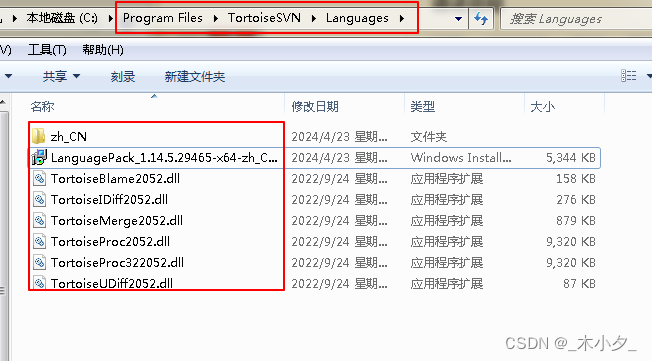

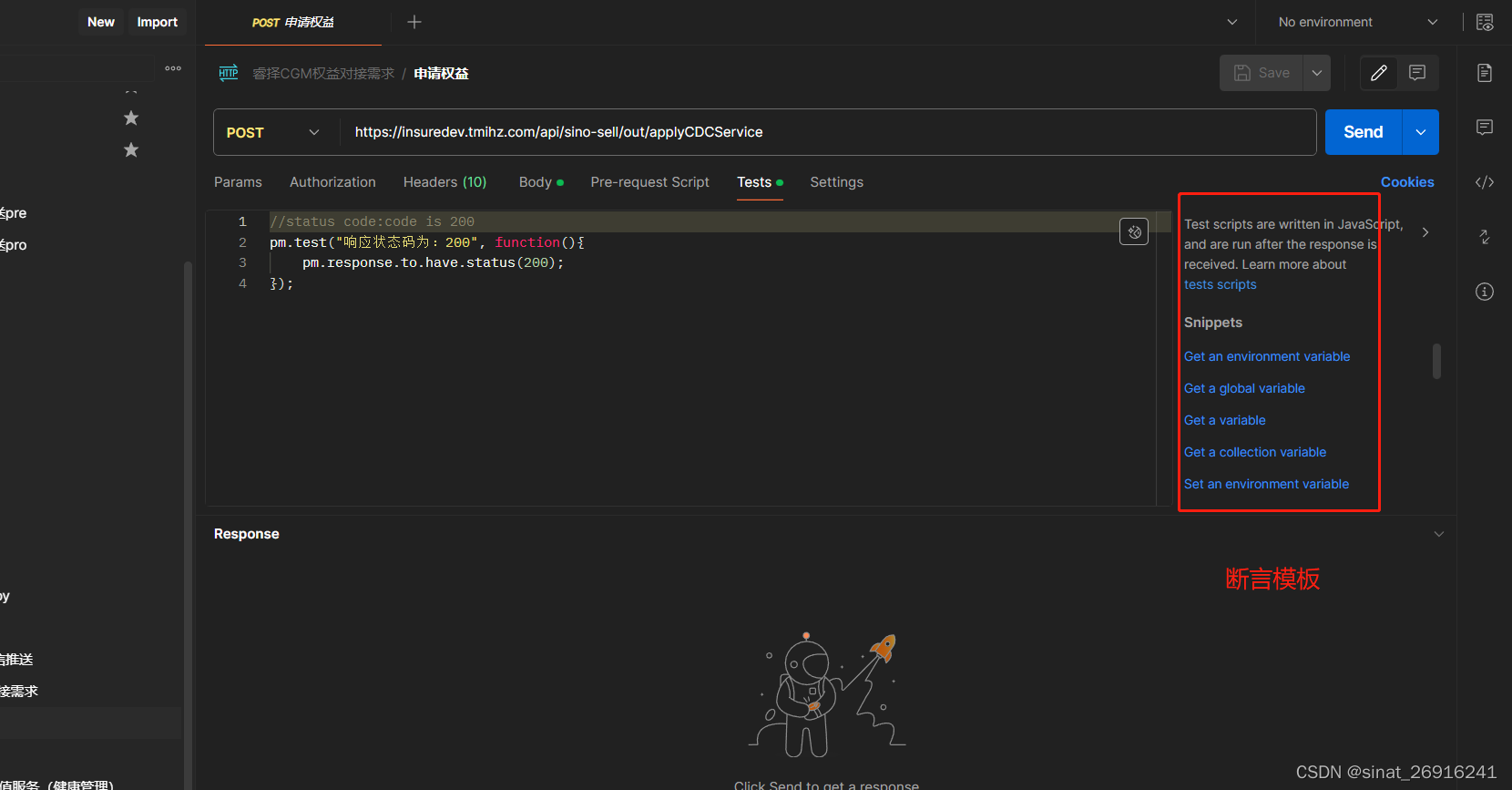


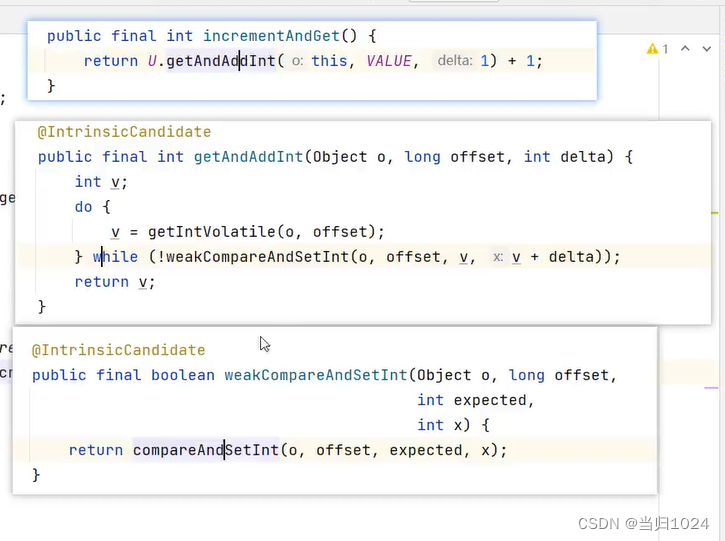
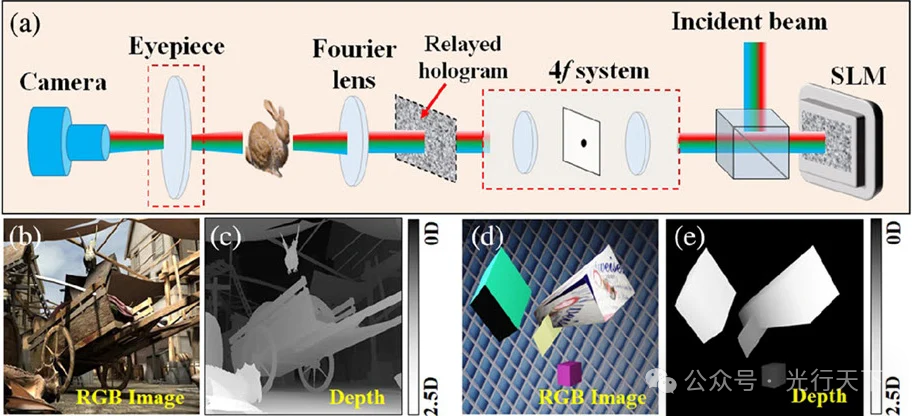

![[部分WP]DASCTF X GFCTF 2024 WEB](https://img-blog.csdnimg.cn/direct/c3f90eaa28e9444199bfedb65ce758de.png)




